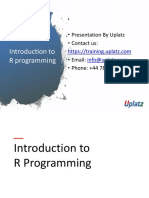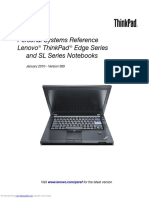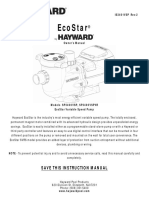Hierarchical Cluster Analysis - R Tutorial
Uploaded by
Vimal PrajapatiHierarchical Cluster Analysis - R Tutorial
Uploaded by
Vimal PrajapatiHierarchical Cluster Analysis | R Tutorial
http://www.r-tutor.com/gpu-computing/clustering/hierarchical-cluster-an...
About Resources Terms of Use
An R Introduction to Statistics HOME DOWNLOAD EBOOK SITE MAP CONTACT
Search this site:
Search With the distance matrix found in previous tutorial, we can use various techniques of cluster analysis for relationship discovery. For example, in the data set mtcars, we can run the distance matrix with hclust, and plot a dendrogram that displays a hierarchical relationship among the vehicles. > d <- dist(as.matrix(mtcars)) > hc <- hclust(d) > plot(hc) # find distance matrix # apply hirarchical clustering # plot the dendrogram
R Tutorial eBook
Careful inspection of the dendrogram shows that 1974 Pontiac Firebird and Camaro Z28 are classified as close relatives as expected.
R Tutorials
R Introduction Elementary Statistics with R GPU Computing with R Distance Matrix by GPU Hierarchical Cluster Analysis Kendall Rank Coefficient
Similarly, the dendrogram shows that the 1974 Honda Civic and Toyota Corolla are close to each other.
Significance Test for Kendall's Tau-b Support Vector Machine with GPU Support Vector Machine with GPU, Part II Bayesian Classification with Gaussian Process Hierarchical Linear Model Installing GPU Packages
Recent Articles
Installing CUDA Toolkit 5.5 on
In general, there are many choices of cluster analysis methodology. The hclust function in R uses the complete linkage method for hierarchical clustering by default. This particular clustering method defines the cluster distance between two clusters to be the maximum
Ubuntu 12.10 Linux August 2, 2013 Installing CUDA Toolkit 5.5 on
1 of 3
1/21/2014 1:40 PM
Hierarchical Cluster Analysis | R Tutorial
http://www.r-tutor.com/gpu-computing/clustering/hierarchical-cluster-an...
distance between their individual components. At every stage of the clustering process, the two nearest clusters are merged into a new cluster. The process is repeated until the whole data set is agglomerated into one single cluster. For a data set with 4,000 elements, it takes hclust about 2 minutes to finish the job on an AMD Phenom II X4 CPU. > test.data <- function(dim, num, seed=17) { + + + } > m <- test.data(120, 4500) > > library(rpud) > d <- rpuDist(m) > > system.time(hclust(d)) user 115.765 system elapsed 0.087 115.914 # complete linkage # load rpud with rpudplus # Euclidean distance set.seed(seed) matrix(rnorm(dim * num), nrow=num)
Fedora 18 Linux August 2, 2013 Hierarchical Linear Model July 22, 2013 Bayesian Classification with Gaussian Process January 6, 2013
By code optimization, the rpuHclust function in rpud equipped with the rpudplus add-on performs much better. Moreover, as added bonus, the rpuHclust function creates identical cluster analysis output just like the original hclust function in R. Note that the algorithm is mostly CPU based. The memory access turns out to be too excessive for GPU computing. > system.time(rpuHclust(d)) user 0.792 system elapsed 0.104 0.896 # rpuHclust with rpudplus
Here is a chart that compares the performance of hclust and rpuHclust with rpudplus in R:
Exercises 1. Run the performance test with more vectors in higher dimensions. 2. Compute hierarchical clustering with other linkage methods, such as single,
2 of 3
1/21/2014 1:40 PM
Hierarchical Cluster Analysis | R Tutorial
http://www.r-tutor.com/gpu-computing/clustering/hierarchical-cluster-an...
median, average, centroid, Wards and McQuittys. Distance Matrix by GPU Tags: GPU Computing with R matrix hierarchical clustering set.seed rpud rpuHclust up cluster analysis dist mtcars hclust complete linkage library matrix Kendall Rank Coefficient dendrogram rnorm distance
plot
rpuDist
Copyright 2009 - 2014 Chi Yau All Rights Reserved Theme design by styleshout Fractal graphics by zyzstar Adaptation by Chi Yau
3 of 3
1/21/2014 1:40 PM
You might also like
- The Demography of Health and Health Care: Second EditionNo ratings yetThe Demography of Health and Health Care: Second Edition385 pages
- _OceanofPDF.com_Data_Visualization_in_R_and_Python_-_Marco_CremoniniNo ratings yet_OceanofPDF.com_Data_Visualization_in_R_and_Python_-_Marco_Cremonini977 pages
- Biostatistics Concepts and Applications For BiologistsNo ratings yetBiostatistics Concepts and Applications For Biologists210 pages
- Post Graduate Diploma in Bio Statistics and Data ManagementNo ratings yetPost Graduate Diploma in Bio Statistics and Data Management4 pages
- Download Complete (eBook PDF) Health Economics: Core Concepts and Essential Tools (Gateway to Healthcare Management) PDF for All Chapters100% (6)Download Complete (eBook PDF) Health Economics: Core Concepts and Essential Tools (Gateway to Healthcare Management) PDF for All Chapters41 pages
- Basic Data Cleaning With Microsoft Excel v1.1No ratings yetBasic Data Cleaning With Microsoft Excel v1.116 pages
- Seefeld-Statistics Using R With Biological Examples PDFNo ratings yetSeefeld-Statistics Using R With Biological Examples PDF325 pages
- Definition, Epidemiology, & Etiology-RenataNo ratings yetDefinition, Epidemiology, & Etiology-Renata2 pages
- Categorical Data Analysis With GraphicsNo ratings yetCategorical Data Analysis With Graphics104 pages
- RYAN, THOMAS P. - [Wiley Series in Probability and Statistics] Modern Regression Methods __ (2No ratings yetRYAN, THOMAS P. - [Wiley Series in Probability and Statistics] Modern Regression Methods __ (2658 pages
- Goals, Process, and Challenges of Exploratory Data Analysis: An Interview StudyNo ratings yetGoals, Process, and Challenges of Exploratory Data Analysis: An Interview Study10 pages
- Diggle 2013 Statistical Analysis of Spatial andNo ratings yetDiggle 2013 Statistical Analysis of Spatial and69 pages
- Ingmar Visser, Maarten Speekenbrink - Mixture and Hidden Markov Models With R (Use R!) - Springer (2022)No ratings yetIngmar Visser, Maarten Speekenbrink - Mixture and Hidden Markov Models With R (Use R!) - Springer (2022)277 pages
- Econometrics in R: Grant V. Farnsworth October 26, 2008No ratings yetEconometrics in R: Grant V. Farnsworth October 26, 200850 pages
- Review On The Role of Small Scale IrrigationNo ratings yetReview On The Role of Small Scale Irrigation18 pages
- Chapter-4 Principal Component Analysis-Based FusionNo ratings yetChapter-4 Principal Component Analysis-Based Fusion27 pages
- Survival Plots SURVMINER Package TutorialNo ratings yetSurvival Plots SURVMINER Package Tutorial5 pages
- Hands-On Data Science With R Text MiningNo ratings yetHands-On Data Science With R Text Mining41 pages
- How To Stack Concrete Paving Moulds For The Best CuringNo ratings yetHow To Stack Concrete Paving Moulds For The Best Curing3 pages
- Ggplot2 Elegant Graphics For Data Analysis (2016, Springer) PDFNo ratings yetGgplot2 Elegant Graphics For Data Analysis (2016, Springer) PDF281 pages
- Buy Ebook Modern Statistics With R From Wrangling and Exploring Data To Inference and Predictive Modelling Second Edition Måns Thulin Cheap Price100% (3)Buy Ebook Modern Statistics With R From Wrangling and Exploring Data To Inference and Predictive Modelling Second Edition Måns Thulin Cheap Price84 pages
- 10Hierarchical&Probabilistic Clustering & GMM (ML)No ratings yet10Hierarchical&Probabilistic Clustering & GMM (ML)24 pages
- Installing and Upgrading Avaya Aura Session ManagerNo ratings yetInstalling and Upgrading Avaya Aura Session Manager76 pages
- Yanmar CANplus 600 Operation and Troubleshooting PDFNo ratings yetYanmar CANplus 600 Operation and Troubleshooting PDF40 pages
- Personal Systems Reference Lenovo Thinkpad Edge Series and SL Series NotebooksNo ratings yetPersonal Systems Reference Lenovo Thinkpad Edge Series and SL Series Notebooks36 pages
- Fisher™ FIELDVUE™ DVC6200 SIS Digital Valve Controller100% (1)Fisher™ FIELDVUE™ DVC6200 SIS Digital Valve Controller116 pages
- HIWIN Linear Servo Actuator - Brochure (En)No ratings yetHIWIN Linear Servo Actuator - Brochure (En)6 pages
- Introducing The Adafruit Bluefruit LE Sniffer: Created by Kevin TownsendNo ratings yetIntroducing The Adafruit Bluefruit LE Sniffer: Created by Kevin Townsend44 pages

























































































